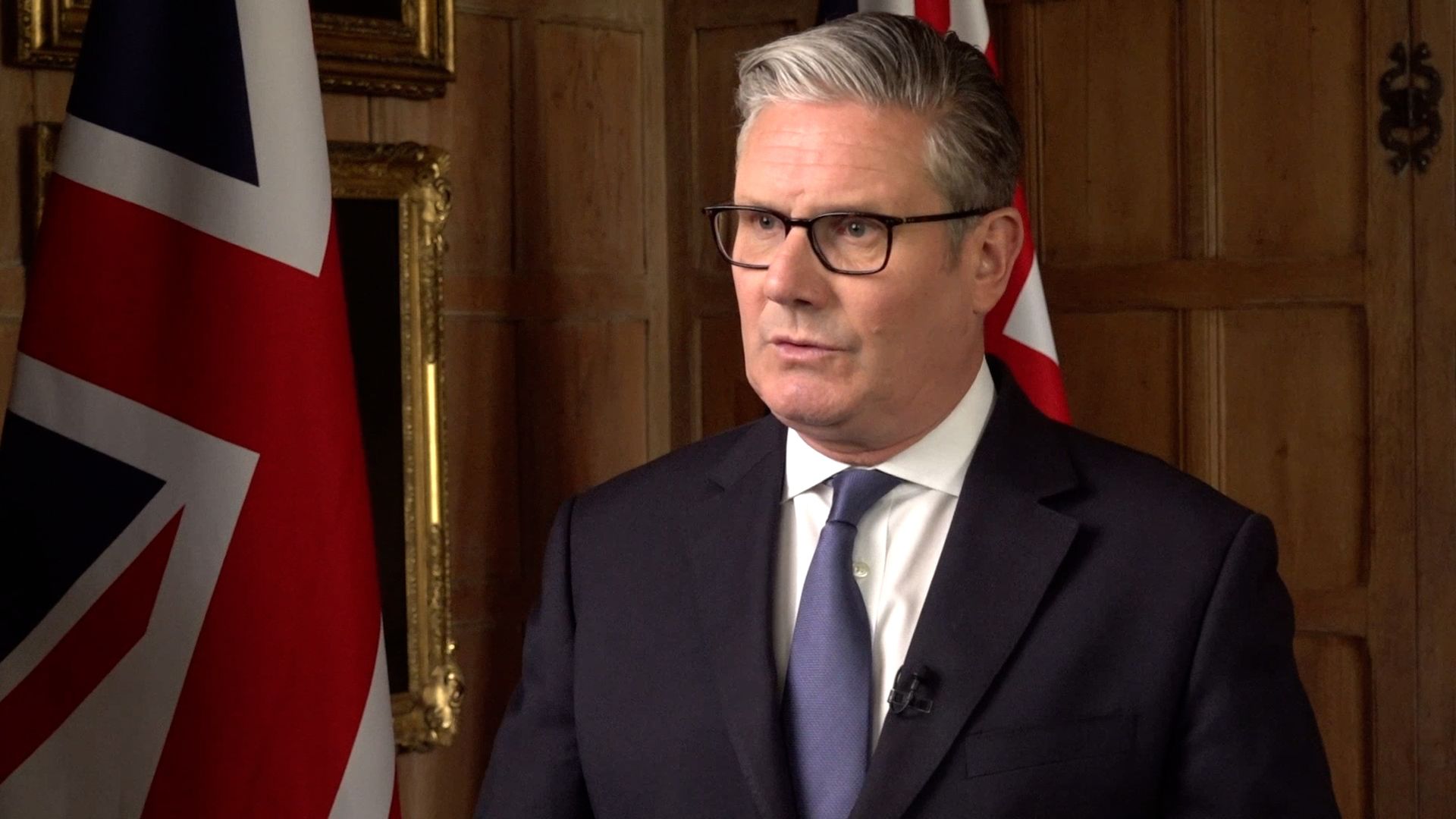
A newly elected Republican chief executive, backed by a cadre of right-wing economists and think tanks, rides a populist wave to victory. Despite inheriting a relatively healthy economy, he unleashes a radical economic policy agenda and defunds government agencies, promising that his actions will usher in a new era of prosperity.
Instead, the economy slows. Budgets collapse. Investors are spooked. Core services erode. Even allies defect. By the end, voters—many of whom once cheered the project—recoil, and a Democrat wins back power.
That’s a version of the scenario Democrats are praying plays out in response to Donald Trump’s second-term agenda—and one Republicans are quietly fearing.
But it is an equally accurate description of what’s happened in Kansas over the past decade and a half. In 2012, after riding a Tea Party wave to victory two years earlier, Kansas Governor Sam Brownback launched what he called “a real live experiment” in conservative governance, slashing income taxes, starving the state budget, and insisting that a burst of economic growth would follow to pay for it all.
But that growth, and fresh tax revenue, never came. To fill his ballooning budget holes, Brownback squandered the state’s surplus, drained the rainy-day fund, fully privatized Medicaid, raided the state’s highway funds, decimated state agencies, and cut public education funding. When the service cutbacks started affecting people’s lives, even Brownback’s own supporters started to notice. Roads fell apart. Class sizes grew. And Brownback’s approval rating sank from 55 percent in his first month in office to 22 percent in 2016. Rather than finish out his second term, he took a job with the first Trump administration in 2017. The following year, Laura Kelly, a Democratic state legislative leader with a clear record of opposing Brownback’s reforms, won the governorship. Four years later, she was reelected, in part by tying her opponent to Brownback. To this day, she is one of the most popular governors in the country.
No political parallel is perfect, of course. Brownback didn’t have the cult following Trump does. On the other hand, the chaos Brownback’s policies caused didn’t kick in for several years, whereas Trump’s shock-and-awe actions have already rattled the country and the world.
We can’t predict the future. But we can look at Kansas. Brownback’s story offers Republicans a warning—and Democrats a possible path to victory.
A lawyer who grew up on a family farm in eastern Kansas, Brownback ran for Congress as a moderate in 1994 but quickly became one of the most radical members of Newt Gingrich’s revolution—so radical, in fact, that he refused to sign the Contract with America because it wasn’t conservative enough. As ambitious as he was ideological, he ran for the Senate two years later, won, and was reelected in 2004, both times with heavy financial support from the Wichita-based Koch brothers. In the 2008 cycle, he entered the GOP presidential primaries as a favorite of the religious right (he had grown up Methodist but converted to Catholicism during his first term in the Senate), didn’t catch fire, and soon set his sights on the Kansas governorship, which he won in 2010 with a plan to make Kansas a model for small-government revival.
In a Republican Party increasingly drawn to theatrics, Brownback was something rarer: a radical ideologue who followed through on his bluster. Whether campaigning for religious freedom abroad—he once emerged as a leading voice in Congress against the genocide in Darfur—or slashing taxes at home, Brownback brought the zeal of a missionary to every cause he took up. His theory for Kansas wasn’t new. It was the old supply-side catechism—cut taxes, shrink government, and wait for growth to swell the coffers and supercharge the economy. What distinguished Brownback was the scale of his ambition and his indifference to evidence.
Brownback went all in on that spring day in 2012. He signed a law that slashed income tax rates, eliminated taxes on pass-through business income, and made no serious effort to offset the losses. Moderate Republicans had hoped to negotiate a more tempered version of the plan in conference committee. They didn’t. Brownback got everything he wanted. His tax regime would go into effect starting New Year’s Day, 2013.
Conservative think tanks cheered the law on. Arthur Laffer—he of the infamous napkin diagram—had helped create the law. Grover Norquist gave his blessing. The Wall Street Journal trumpeted a Cato Institute report giving Brownback an A grade for “the biggest tax cut of any state in recent years relative to the size of its economy.”
The laboratory was well chosen. Kansas was—and remains—deep red. Since 1940, it has voted for every Republican presidential nominee with the exception of Lyndon Johnson. Much like the libertarian bend in the American psyche, if you tell Kansans you are going to lower their taxes, cut government expenses, and make programs more efficient, they’ll give you a great deal of leeway.
But beneath Kansas’s right-wing surface lies a persistent ideological split. The state’s Republican electorate includes both hard-line religious conservatives and a sizable bloc of moderates. That tension helps explain why Kansas has a long tradition of electing centrist Republicans—and even the occasional Democrat—to the governor’s mansion.
“Kansas is Republican,” one former state Republican politician told me, “but it’s not crazy.”
Almost immediately after the cuts went into effect, state revenues plunged. By June 2013, just six months into the new tax regime, Kansas was $338 million short of its revenue projections. Within a year, the state had lost nearly $700 million—an 11 percent drop in revenue. Credit downgrades followed. But the administration continued to insist that growth was coming. Brownback dismissed economists’ warnings and suppressed internal projections that contradicted the party line.
Job growth didn’t materialize. Brownback had promised 100,000 new private-sector jobs. By 2014, a year into the “experiment,” the state had added fewer than 20,000—well behind national trends and trailing neighboring Missouri and Colorado. According to the Center on Budget and Policy Priorities, the year the cuts took effect, the Kansas economy shrank, even as the national economy grew. Then, in 2014, the state’s economy grew but still lagged the national average. By 2015, Kansas’s real GDP was growing at half the rate of the national economy. According to the CBPP, five of the previous six years before the tax cut, Kansas’s economy had grown faster than the nation’s as a whole.
What did expand—quickly and predictably—was income tax avoidance. Pass-through entities multiplied practically overnight as doctors, lawyers, and accountants restructured to avoid paying state income taxes. “I’m making out like a bandit,” one attorney told The Kansas City Star. “And it’s completely unfair,” he complained, because his secretary, like most Kansans, still paid full freight.
Before a critical mass of voters caught on, Brownback’s administration was able to paper over the fiscal collapse with budget chicanery. It drained the state’s budget surplus, moved money from the highway fund, cut the state’s pension fund contributions, and tightened eligibility requirements for programs assisting the poor.
The result was a slow bleed: Agencies were hollowed out gradually, and the most vulnerable Kansans suffered, but the daily lives of most voters hadn’t yet been directly affected by the time the 2014 elections rolled around. As Ashley All, a veteran Democratic operative in Kansas, told me, “They were able to conceal the scale of the crisis just long enough.” Brownback squeaked by to reelection, aided in part by a well-timed reminder that his opponent had visited a strip club 16 years earlier.
It wasn’t until after the election that Brownback was forced to take actions that shocked average voters. Two weeks into his second term, another round of credit rating downgrades further raised the state’s borrowing costs and led to more budget cuts in education and infrastructure. Brownback slashed $45 million from school budgets to fill the growing hole. That forced some school districts, already cash strapped from the governor’s previous cuts, to begin sending students home at two p.m. Others canceled classes on Fridays or started summer vacation early. Working parents, left in a lurch, had to scramble to find child care. “We felt we didn’t have a choice,” said Janet Neufeld, superintendent of the Twin Valley School District, which then served 590 students in eastern Kansas. The district ended its academic year 12 days early that year. “It’s not good for kids, it’s not good for families,” Neufeld told Bloomberg. “There have been times when things were tight, but this is the absolute worst I’ve ever seen it,” Mike Sanders, superintendent of the Skyline School District, said at the time. Even parents in districts that didn’t impose such drastic service cuts read or heard about them in the media and worried that their schools would be next.
Meanwhile, the governor shelved 24 highway expansion and modernization projects, including ones he’d campaigned on, such as a $29 million widening of a dangerous 24-mile stretch of K-177 known for rollover accidents and blind curves. During Brownback’s first term, almost 50 percent of all highway fatalities recorded in Kansas occurred on roads like K-177: two-lane highways with no controlled access. “New Budget Deal Postpones Upgrades on Lethal Two-Lane Roads, Harrowing Intersections,” read a Topeka Capital-Journal headline. Republican legislators joined Democrats in blasting the broken promise.
And then came the great irony. Having promised sweeping tax relief, but facing a $400 million shortfall and another credit downgrade, Brownback signed the largest tax increase in Kansas history. Yet rather than place the burden on high-income individuals who had benefited from his first-term reductions, the new law raised the state sales tax, including on groceries, and hiked cigarette taxes, disproportionately penalizing middle- and lower-income Kansans. Conservative lawmakers wept as they voted affirmatively. (Cue the world’s smallest violin.) Brownback insisted that it wasn’t a tax hike—“Look at the totality,” he said. “Overall, it’s still a net tax cut.” But even Grover Norquist called it what it was: a violation of his “Never raise taxes” mandate, and one that particularly punished the poor.
“It wasn’t abstract anymore,” Ashley All, who served as communications director for Laura Kelly’s 2018 campaign, told me. “Parents were paying extra at the grocery store and seeing 30 kids in a classroom. People were noticing delays on roads. You didn’t need to follow politics whatsoever to understand something had gone very wrong.”
The experiment had obviously failed. But the governor wasn’t done defending it. He blamed “media elitists,” “leftists,” and “liberal outside groups” for misleading the public. “Some at the local Missouri-based paper in Kansas,” he warned in bold-faced type in one fund-raising letter, had “even taken to openly rooting for the Kansas economy to fail.”
The political system finally caught up in the 2016 midterm elections. That year a group of moderate Republicans targeted Brownback-allied legislators in the primaries, running on a promise to restore school funding. It worked. More than a dozen Brownback allies lost their seats to moderates. In November, Democrats, also running on schools, flipped 12 additional seats. What emerged was an unusual, and tenuous, coalition: Democrats like Laura Kelly, a veteran state senator who had opposed the tax cuts from the beginning, moderate Republicans, and disaffected former Brownback allies who had decided enough was enough.
Don Hineman, a rancher from Dighton and self-described “Eisenhower-Dole-Kassebaum Republican,” had broken with Brownback and won reelection that year. He served as house majority leader during the legislature’s repeal of the tax cuts. “By 2016, it was obvious to a lot of Kansans that things had gone too far,” Hineman told me. “You didn’t need a spreadsheet. You just had to look around.”
In 2017, Hineman’s coalition succeeded where years of external pressure had failed. The legislature passed a repeal of major provisions of Brownback’s tax plan, including the notorious LLC loophole, over the governor’s veto. The votes were bipartisan. The Republican senate majority leader at the time, Jim Denning, who had supported the original tax bill in 2012, offered a quiet admission from the floor: “I’ve made many bad business decisions … ,” he said. “But I’ve always backed up and mopped up my mess.”
This alone was remarkable: a Republican legislature repudiating the ideological centerpiece of its own governor’s administration, over his flailing objection. Moderation reasserted itself—not just as temperament, but as a governing necessity. If Brownback’s tax plan had been an experiment, the results were in—and the legislature was cleaning up the lab.
Brownback left office early in 2017 to join the Trump administration as ambassador-at-large for international religious freedom. By then, his approval ratings had cratered into the 20s, and he was widely considered one of the most unpopular governors in the country. Yet his presence lingered over Kansas politics—not only because of what had happened, but also because of how distinctly it was tied to an ideological vision of government.
Lieutenant Governor Jeff Colyer finished out the remainder of Brownback’s term but lost the 2018 Republican primary to Kris Kobach, a former law professor, national anti-immigration figure, and vice chair of Trump’s short-lived “election fraud” commission. Kobach was cut from the same cloth as Brownback, and he made little effort to distance himself. At a televised debate, when asked if he thought Brownback was a good governor, Kobach raised his hand. The moment became the centerpiece of Democrat Laura Kelly’s advertising strategy.
“It was devastating,” Samantha Poetter, a current Republican state representative and Kobach’s communications director at the time, told me. “That debate clip probably played a large part in his downfall.” According to Poetter, the backlash wasn’t about abstract economics. “Probably 75 percent of it was the schools,” she said. “People felt that.”
Kelly won by five points in a state Trump had carried by more than 20. Coupled with her shrewd promises to restore government functions and offer tax relief for the working class, the campaign message—Don’t go back to Brownback—stuck.
And Kelly didn’t just campaign against Brownbackism—she governed against it. In her first term, she vetoed two Republican tax cut bills, warning that they would reopen the fiscal wounds Kansans had just started to stitch shut. She restored funding to schools, preserved a $1.1 billion surplus, paid down debt and pensions, and, importantly, steered relief toward working families—making good on her campaign promise to phase out the massive sales tax Brownback had imposed.
In 2022, Kelly faced a different political environment. National Democrats were focused on abortion rights after Dobbs, but Kansas voters had already rejected an anti-abortion constitutional amendment. Kelly’s team made a strategic decision: They wouldn’t run a single TV ad on the issue. Instead, they went back to what worked. Her Republican opponent, Derek Schmidt, hadn’t spearheaded the Brownback agenda—but he hadn’t opposed it either.
“We knew from our data that Brownback was still toxic.” Jordanna Zeigler, a senior adviser on Kelly’s campaign, told me. “The association was still damaging.” With middle-class tax cuts of her own to flaunt, Kelly tied her opponent to the miserable upper-income tax-cutting experiment of Brownback.
Schmidt tried to nationalize the race, tying the Democratic governor to Joe Biden, inflation, and culture war issues like trans athletes. It didn’t work, because Kelly, who understood the politics of her state, neither ran nor governed as an ideological progressive. Her signature 2022 campaign ad featured her standing in the middle of a road bragging about how she worked with Republicans and Democrats to turn budget deficits into surpluses while funding schools and roads. She won reelection.
As recently as last year, she vetoed a bipartisan tax cut bill that she believed endangered the budget’s long-term stability. In Kansas, fiscal restraint has turned out to be good politics. Her approval ratings now hover in the mid-50s, among the highest of any governor in the country.
Brownback isn’t the only Republican once considered untouchable who later became politically toxic thanks to a fatal cocktail of ideological economic policy and government service failure. In early 2005, President George W. Bush, recently reelected with rock-solid support from an adoring conservative base, despite the war going badly in Iraq, announced a plan to partially privatize Social Security. The more average Americans learned about the plan, the more they hated it, and the GOP majority in Congress refused to bring the plan up for a vote. As that drama was playing out, Hurricane Katrina struck New Orleans. Blame for FEMA’s shamefully shambolic response fell on the president for putting inexperienced federal managers (“Brownie, you’re doing a heck of a job”) in charge of the agency. Bush’s approval ratings never recovered. When he left office in 2009 amid a collapsing economy, even hard-core conservatives had abandoned him.
Donald Trump might seem different—invulnerable, able again and again to defy political gravity. But remember what lost him reelection in 2020: his chaotic mismanagement of the COVID pandemic. He returned to power in 2024 largely on voters’ memories of the strength of the economy during his first three years as president—an economy he inherited from Barack Obama. Now he is pushing through radical policies that threaten to undermine both the economy and vital government services. If both come to pass on his watch in ways that reach the everyday lives of Americans, it’s worth considering that he, too, could leave office in disgrace and become an anchor around the necks of the Republicans for years to come.
Don Hineman, the moderate Republican rancher who led the repeal of Brownback’s tax cuts in the statehouse, sees the parallels. “I think what’s happening on the national level is pretty much a replay of what happened to Kansas between 2012 and 2018,” Hineman told me. “The anger is bubbling every day.”
And that could redound to the long-term benefit of Democrats—if they find a leader who is savvy enough to understand and give average voters the policies they want and need.
The post Donald Trump Is Following the Sam Brownback Playbook appeared first on Washington Monthly.


 2 months ago
17
2 months ago
17 



.jpg.webp?itok=1zl_MpKg)





 Bengali (Bangladesh) ·
Bengali (Bangladesh) ·  English (United States) ·
English (United States) ·